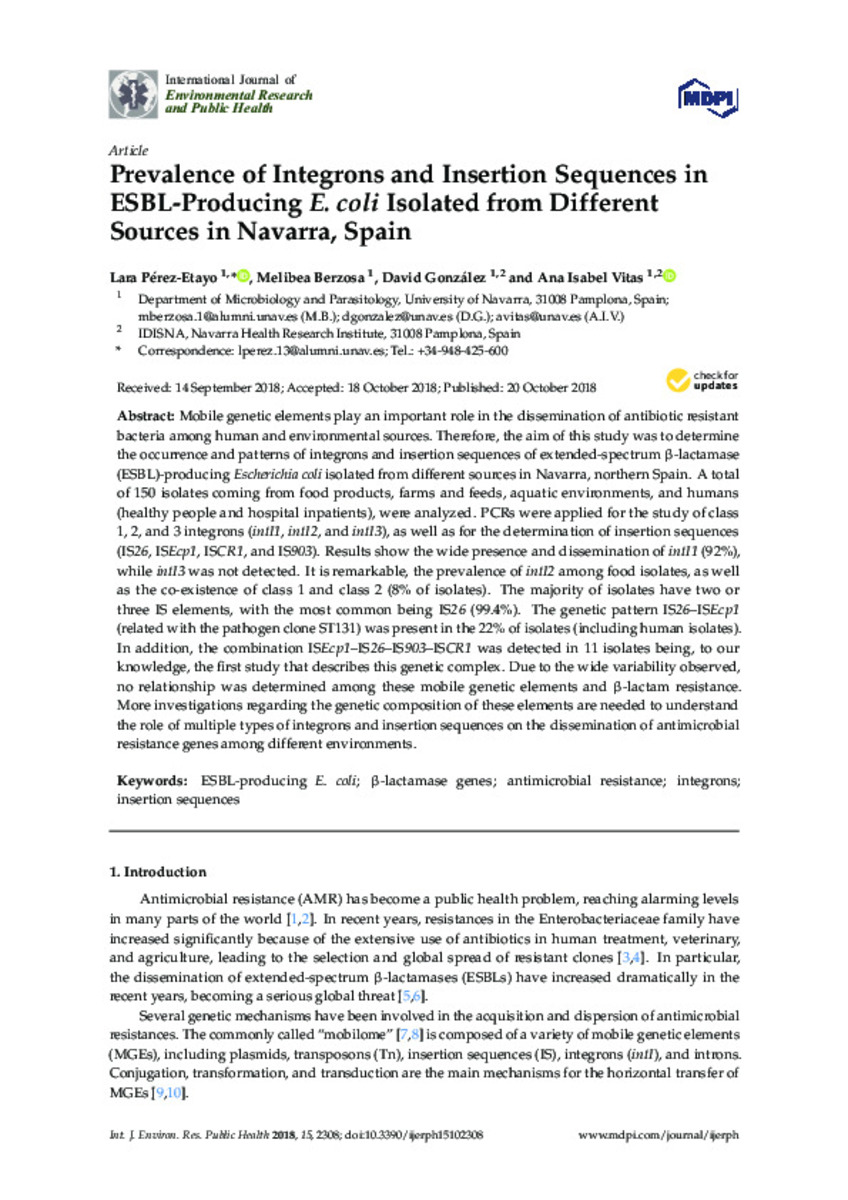Full metadata record
| DC Field | Value | Language |
|---|---|---|
| dc.creator | Pérez-Etayo, L. (Lara) | - |
| dc.creator | Berzosa-Suñer, M. (Melibea) | - |
| dc.creator | González, D. (David) | - |
| dc.creator | Vitas, A.I. (Ana Isabel) | - |
| dc.date.accessioned | 2022-10-06T08:15:09Z | - |
| dc.date.available | 2022-10-06T08:15:09Z | - |
| dc.date.issued | 2018 | - |
| dc.identifier.citation | Pérez-Etayo, L. (Lara); Berzosa-Suñer, M. (Melibea); González, D. (David); et al. "Prevalence of integrons and insertion sequences in ESBL-producing E-coli isolated from different sources in Navarra, Spain". INTERNATIONAL JOURNAL OF ENVIRONMENTAL RESEARCH AND PUBLIC HEALTH. 15 (10), 2018, E2308 | es |
| dc.identifier.issn | 1660-4601 | - |
| dc.identifier.uri | https://hdl.handle.net/10171/64391 | - |
| dc.description.abstract | Mobile genetic elements play an important role in the dissemination of antibiotic resistant bacteria among human and environmental sources. Therefore, the aim of this study was to determine the occurrence and patterns of integrons and insertion sequences of extended-spectrum β-lactamase (ESBL)-producing Escherichia coli isolated from different sources in Navarra, northern Spain. A total of 150 isolates coming from food products, farms and feeds, aquatic environments, and humans (healthy people and hospital inpatients), were analyzed. PCRs were applied for the study of class 1, 2, and 3 integrons (intI1, intI2, and intI3), as well as for the determination of insertion sequences (IS26, ISEcp1, ISCR1, and IS903). Results show the wide presence and dissemination of intI1 (92%), while intI3 was not detected. It is remarkable, the prevalence of intI2 among food isolates, as well as the co-existence of class 1 and class 2 (8% of isolates). The majority of isolates have two or three IS elements, with the most common being IS26 (99.4%). The genetic pattern IS26–ISEcp1 (related with the pathogen clone ST131) was present in the 22% of isolates (including human isolates). In addition, the combination ISEcp1–IS26–IS903–ISCR1 was detected in 11 isolates being, to our knowledge, the first study that describes this genetic complex. Due to the wide variability observed, no relationship was determined among these mobile genetic elements and β-lactam resistance. More investigations regarding the genetic composition of these elements are needed to understand the role of multiple types of integrons and insertion sequences on the dissemination of antimicrobial resistance genes among different environments. | es_ES |
| dc.description.sponsorship | This research was funded by a grant of the “Asociación de Amigos de la Universidad de Navarra”, obtained in September 2016 | es_ES |
| dc.language.iso | eng | es_ES |
| dc.publisher | MDPI AG | es_ES |
| dc.rights | info:eu-repo/semantics/openAccess | es_ES |
| dc.subject | ESBL-producing E. coli | es_ES |
| dc.subject | β-lactamase genes | es_ES |
| dc.subject | Antimicrobial resistance | es_ES |
| dc.subject | Integrons | es_ES |
| dc.subject | Insertion sequences | es_ES |
| dc.title | Prevalence of integrons and insertion sequences in ESBL-producing E-coli isolated from different sources in Navarra, Spain | es_ES |
| dc.type | info:eu-repo/semantics/article | es_ES |
| dc.description.note | This article is an open access article distributed under the terms and conditions of the Creative Commons Attribution (CC BY) license (http://creativecommons.org/licenses/by/4.0/). | es_ES |
| dc.identifier.doi | 10.3390/ijerph15102308 Free PMC article | - |
| dadun.citation.number | 10 | es_ES |
| dadun.citation.publicationName | INTERNATIONAL JOURNAL OF ENVIRONMENTAL RESEARCH AND PUBLIC HEALTH | es_ES |
| dadun.citation.startingPage | E2308 | es_ES |
| dadun.citation.volume | 15 | es_ES |
Files in This Item:
Statistics and impact
Items in Dadun are protected by copyright, with all rights reserved, unless otherwise indicated.






